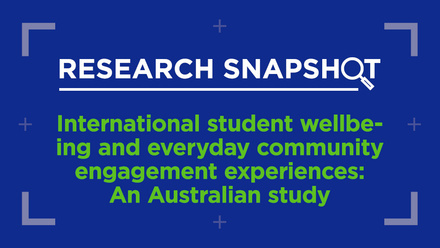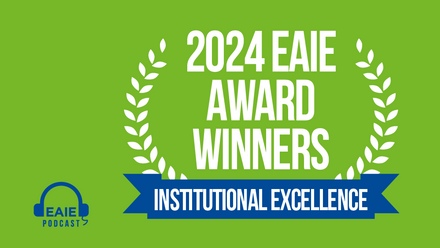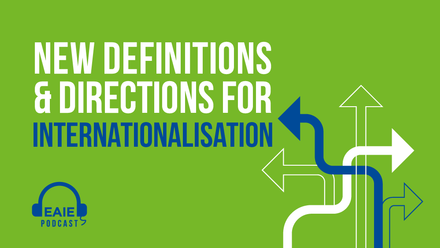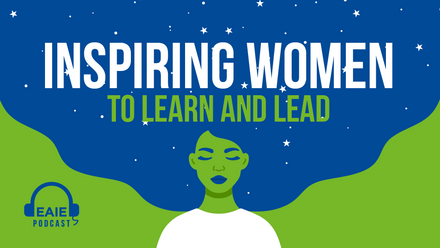Tools and mental models for internationalising with society

The just-launched Winter 2022 issue of EAIE Forum magazine looks at the complex and evolving relationships between universities and the local and global communities in which they are situated. As we continue reflecting on this theme on the blog this week, today’s blog post dives deeper into internationalisation of higher education for society (IHES) and the nuts and bolts of how institutions can start carrying out its principles.
Higher education institutions (HEIs) are not stand-alone organisations, but operate in multiple, and sometimes overlapping, contexts, systems and societies. HEI strategies and activities intersect with those of a wide range of other stakeholders and communities both locally and globally. How then, can HEIs ensure that these intersections are not merely haphazard or isolated, but strategically planned, implemented and developed intentionally and in a structured way together with the communities they serve?
Achieving social change together with our communities
Internationalisation of Higher Education for Society (IHES) highlights the importance of discovering the needs of our local and global communities, and aligning our HEI service missions and internationalisation strategies to better engage with and benefit these communities. With the continuously increasing interconnections, complexity and wicked problems globally as well as diversifying communities locally, I believe we need a further shift from aligning strategies and missions within an HEI to better serve its societies, to actually creating these strategies and missions to achieve social change in collaboration with our societies – not only for them.
We need a further shift from aligning strategies and missions within an HEI, to actually creating them in collaboration with our societies
We might use the teachings of collective impact to think more broadly and holistically about the dynamics between HEIs and their local and global communities. It takes us beyond collaboration, individual projects and partnerships, to integrated and lasting networks with shared infrastructure, staff, resources and a structured process for achieving impact. This means mapping relevant stakeholders, bringing them together and deciding on a common agenda, as well as using tools for shared communication, measurement and accountability.
The University of Georgia Archway Partnership is an example of this. It was co-created by the university and various stakeholders in its local communities. Instead of the university assuming a leading role through individual outreach initiatives, the equitable partnership was established as a neutral backbone organisation to coordinate and facilitate mutually-beneficial and long-term social change, by engaging the entire university on issues identified by the communities.
Underlying mental models are the core of systems change
Such a shift from mainly operating as individual organisations with isolated partnerships, projects and collaborations with external stakeholders is a major change process for HEIs. This kind of strategical and operational shift requires a shift also in mindsets at all levels of the organisation. Systems change is essentially about changing the conditions that are upholding the current system. Changing the more structural issues of an organisation, such as policies and practices, might not have the desired effect if the underlying mindsets remain intact. The same is true for changing relationships and power within the organisation. In order to achieve transformative change in a system (for example an HEI) the underlying mental models in the system must be changed.
Enabling change requires change management, which is not only about the actual change process, but also about preparing, training, and supporting the people involved in the change in order for the process to succeed. This implies a significant need for competence development for staff and management within HEIs to adapt to their new, more complex, international, interconnected and collaborative work environments and tasks. This is equally true for other organisations and stakeholders in societies locally and globally who wish to engage with HEIs for collective impact. One mission of HEIs then becomes to not only possess these competences themselves, but to provide learning opportunities for others to develop them. This is a major part of the collective impact HEIs can contribute to and could constitute an enormous transformative power for both universities and their societies.
Tools for exploring the whole system, not merely its parts
Systems thinking provides a broad range of tools to examine HEIs and their contexts, ie communities, to map actors and activities, to understand connections and identify patterns as well as considering multiple perspectives, values, beliefs and priorities. These same tools can be used for planning action and for evaluating and developing the HEIs and their communities as systems. Systems thinking is a mindset which is required to move away from traditional hierarchical and linear ways of thinking and operating, currently still very common in HEIs. In order to look at any issue more closely one must not merely understand each part separately but the parts and the whole simultaneously. Only then is it possible to change the whole system and not only its parts.
Systems leadership revolves around a commitment to the system functioning as a whole and as such involves many stakeholders, constant iterations, experimentation, and learning together in the system and between systems. The role of the systems leader becomes to foster collective leadership by helping others see the whole system in order to understand the complex issues within it and to become agents of change themselves. This means a new way of leading HEIs and the different processes within them. It means letting go of power and distributing it to others, sometimes even outside the organisation.
According to the late professor Josef Mestenhauser, we, as international educators constantly operating in multidimensional and intercultural contexts have a unique opportunity to not only make use of a systems thinking mindset to solve complex and interconnected issues but to teach others to do the same. He emphasised the need for internationalisation of higher education to be used for addressing societal challenges and for these efforts to be comprehensive and coordinated in order to be sustainable.
Internationalisation of higher education with society
By connecting IHES with a systems thinking mindset with the aim of achieving collective impact through change management universities have unimaginable potential to work together in a structured way with their communities locally and globally. This requires a shift from viewing internationalisation of higher education as something which is done for society, to something which is done in collaboration with society. It means moving from service, contribution and benefit "to", or impact "on", society, to an even more collective approach with mutually aligned strategies, operations, resources and assessment for greater impact, not only on society but also on higher education.






